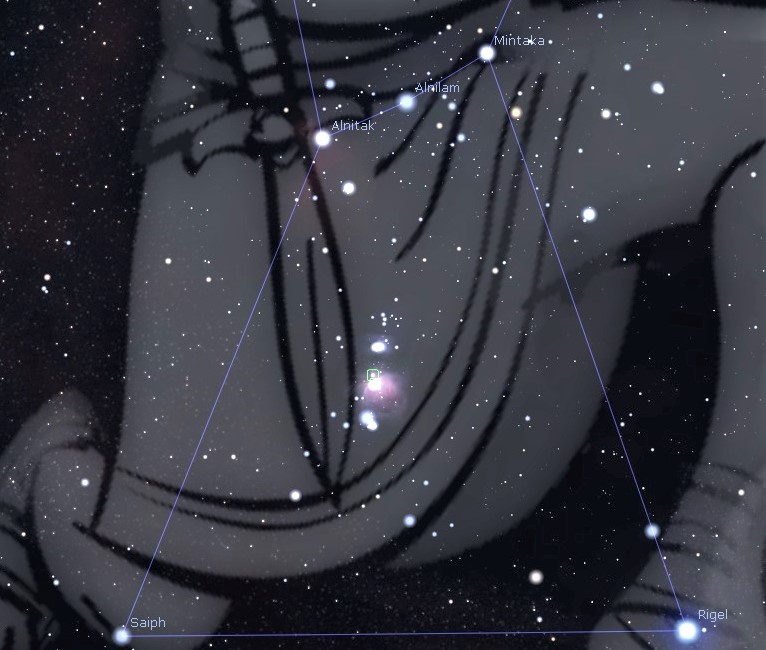This Week’s Sky at a Glance, 2022 February 12 – 19 ~by Curt Nason
Binoculars are great instruments for observing the brighter star clusters and nebulae in the night sky, and Orion is a great place for binocular treasures. Its most prominent naked eye feature is the angled line of three stars that make Orion’s Belt. This trio, part of a star cluster called Collinder 70, will fit easily within almost any binocular view. They are hot giant stars with the one on the right, Mintaka, being a little dimmer than Alnitak on the left and Alnilam in between. Although they appear to be near each other, at a distance of 2000 light years Alnilam is nearly three times farther than the other two. Between Alnilam and Mintaka binoculars will show an S-shaped asterism, Orion’s S, which peaks above his belt.
Below the belt is a string of a few dimmer stars that makes Orion’s sword, one of which looks fuzzy to the eye. Binoculars reveal this to be the Orion Nebula or M42, a vast cloud of gas and dust where stars are forming. Just above the nebula is an asterism that resembles a person running or perhaps the figure in a WALK sign. Several double or multiple stars can be seen in this general area. Binoculars will also enhance star colours so check out Orion’s two brightest stars, blue-white Rigel and orange Betelgeuse. De-focussing your binoculars slightly will enhance the colours even more.
This Week in the Solar System
Saturday’s sunrise in Moncton is at 7:26 am and sunset will occur at 5:40 pm, giving 10 hours, 14 minutes of daylight (7:30 am and 5:47 pm in Saint John). Next Saturday the Sun will rise at 7:15 am and set at 5:51 pm, giving 10 hours, 36 minutes of daylight (7:19 am and 5:57 pm in Saint John).
The Moon is full on Wednesday; the Snow Moon, Hunger Moon or Snow Blinding Moon. With later sunsets it won’t be long before we lose Jupiter to evening twilight as it heads toward solar conjunction on March 5. Venus is now at its brightest for this morning apparition, sitting seven degrees north of Mars on Sunday. Mercury is at its greatest elongation from the Sun on Wednesday, visible a little more than a fist-width lower left of Venus and Mars. Saturn rises just 20 minutes before sunrise so it will be unseen over the week.
On Sunday evening at 8 pm, tune in to the Sunday Night Astronomy Show via the Facebook page or YouTube channel of Astronomy by the Bay.
Questions? Contact Curt Nason.

